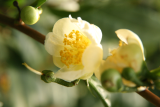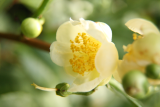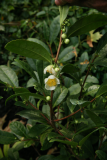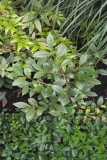Additional notes (click to expand)
Commemorative
The leaves of Camellia sinensis are dried to make the tea we drink; the genus name commemorates
Georg Josef Kamel (1661–1706), a Jesuit pharmacist born in Moravia (Czech Republic). He went as a Jesuit priest to the Marianas in 1683 and Manila in the Philippines in 1688, and set up the first pharmacy there. He sent plants found in the gardens of the Chinese to the botanist John Ray (1627–1705) in England, who published his work in an appendix to his own Historia plantarum (1686–1704) as Herbarum aliarumque stirpium in insula Luzone Philippinarum (1704) (Herbs and other plants in the island of Luzon in the Phillipines). It is unlikely that Kamel found camellias as he never went to Japan or China, but his work on the flora of the Far East was substantial, and merited the recognition. He also wrote Observationes de avibus Philippensibus (1702), the first account of the birds of the Philippines.
Oakeley, Dr. Henry. (2012). Doctors in the Medicinal Garden. Plants named after physicians. Royal College of Physicians.
link
Horticulture
The evergreen Camellia sinensis is a frost-hardy shrub in the Theaceae family. It comes from west China, where summers are warm and wet and winters are dry and frost-free. In the Medicinal Garden it grows in a sheltered position in partial shade; dainty white, scented flowers appear in autumn and winter. It prefers rich, acidic soil, so plenty of organic matter was incorporated on planting, and during the growing season it is fed monthly with an organic, seaweed-based, fertiliser.(by Clare Beacham)
Oakeley, Dr. Henry. (2012). Doctors in the Medicinal Garden. Plants named after physicians. Royal College of Physicians.
link
Medicinal
Camellia sinensis. Caffeine and theophylline. Coffea arabica. When the habits of drinking tea made from C. sinensis leaves, and coffee made from berries of Coffea arabica became established in Europe in the 17th century, it was soon realised that they could cause the production of more urine than the volume drunk. It took more than 200 years to understand that both contained simple chemicals Theophylline and Caffeine that acted on the kidney to increasing the production of urine, diuresis. This used to be medically important because the effect could be used to treat diseases arising from failure of normal control of the water in the body such as in heart failure. Nowadays other, more powerful diuretics are available and both drinks are enjoyed for other reasons.
William Harvey and plant derived medicines currently used in cardiovascular medicine, Prof Michael de Swiet's Notes 2018
Prescription only medicine: Theophylline. A concentrated Green Tea Extract taken by mouth as a slimming aid has been proposed but it has caused liver damage in some subjects and is not now considered safe. An ointment containing 10% of a particular green tea extract has been approved as an effective prescription treatment for genital warts. Its principal adverse effect is irritation of the skin around the site of application. The mechanism of this activity is not known.
NICE (National Institute for Health and Care Excellence), 2015, 'External genital and perianal warts: green tea (Camellia sinensis) leaf extract 10% ointment' https://www.nice.org.uk/guidance/esnm66/resources/external-genital-and-perianal-warts-green-tea-camellia-sinensis-leaf-extract-10-ointment-1502681108581573
Potential mood altering, anti-cancer and anti-infective activities of tea preparations and isolated chemical constituents are reviewed
Nature Outlook 2019, 566, February 11th, Tea
Other use
Tea was first brought to Europe in 1610 and by 1750 had become the British national drink, with 18,000 tonnes imported annually. It remained a monopoly for the Chinese until the beginning of the 19th century when Dr Siebold (qv under Primula sieboldii) smuggled seeds to Java to set up tea growing there. In 1848 and subsequent years, the British plant hunter Robert Fortune (1812–89) smuggled 100,000 tea plants and seedlings to Darjeeling, India, accompanied by Chinese tea growers, for the East India Company, and set up the Indian tea plantations. Fortune not only used the Wardian cases – watertight boxes with glass tops – for shipping plants, but also sowed seed into earth in the cases and these germinated in transit, ready for planting out on arrival (Cox, 1945).
Oakeley, Dr. Henry. (2012). Doctors in the Medicinal Garden. Plants named after physicians. Royal College of Physicians.
link
Only marginally hardy, this small shrub seems happy in the Medicinal Garden. The leaves are the source of tea, drunk principally for its stimulating effect. This is due mainly to its caffeine content with small amounts of theophylline and theobromine. The dry leaf contains more caffeine than coffee, but less of it by weight is used in making a cup, so tea as a beverage is less stimulating. The various different types of tea – black, green and white – have their different fl avours due solely to the preparation method and the quality of the leaf. It was unknown to the 16th-century herbalists, coming as it did from China. Tea was first brought to Europe in 1610 and by 1750 had become the British national drink with 18,000 tonnes imported annually. Worldwide, 3.5 million tonnes of tea are now harvested annually.
Oakeley, Dr. Henry. (2011). A Year in the Medicinal Garden of the Royal College of Physicians, revised edition. Royal College of Physicians, London. p.93
link
Current agronomic aspects of the tea industry, genomic studies, attempts at genetic manipulation of tea plants and effects of environment on growth and composition of tea are reviewed
Naature Outlook 2019, Feb 11th, Tea, pp1-11
Phytochemistry
Brief review of current knowledge of epicatechin gallate, theanine, caffeine and other chemical constituents and of relevant genetics.
Nature Oulook 2019, Feb 11th, pp1-11
Toxicity
Contains Quercetin, a Flavonoid. Not carcinogenic but is genotoxic.
van den Berg, S.J.P.L., Restani, et al., P.. (2011). Levels of Genotoxic and Carcinogenic Compounds in Plant Food Supplements and Associated Risk Assessment. Food and Nutrition Science 2: 989-1010.
link
Geographical distribution
- Asia-Temperate, China
Camellia sinensis (L.) Kuntze
Family: THEACEAEGenus: Camellia
Species: sinensis (L.) Kuntze
Common names: Tea
Distribution summary: W.China
Habit: Shrub
Hardiness: H3 - Half hardy; unheated greenhouse/mild winter
Habitat: Deciduous forests, damp, shady spots
Garden status: Currently grown
Garden location: Plants in pots (POT)
Flowering months: March, April, May
Reason for growing: Commemorative, medicinal, prescription only medicine



.JPG)

